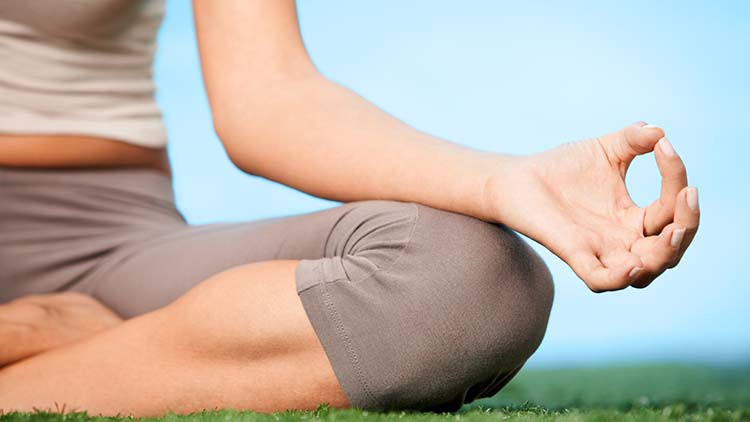What is Mindfulness?
Simply put, practicing mindfulness means to just pay attention and the act of being mindful means to be conscious and aware of the present moment. This also means being aware of the sounds and movement around you and the feelings in your body. This isn’t about focus and concentration though – just non-judgemental observance and awareness.
This can be done just for a few seconds, while completing a mundane task, or by consciously taking time to sit in a meditative state, at some point during your day.
While mindfulness historically comes from the Buddhist tradition, it is now considered a secular tool for anyone and is even being incorporated into the workplace by companies who want to improve the health and productivity of their employees.
The result of mindfulness is an improvement to overall well-being, that can include everything from lower stress to better sleep. It has helped those with addictions and chronic pain and it can even be attributed to positive physiological changes, such as lowered blood pressure and improved brain health.
Is Mindfulness a Real Thing?
You might be thinking, this sounds all well and good but it also sounds a bit esoteric and maybe even a little bit hokey. Is mindfulness actually real, from a scientific standpoint and does it have any legs to stand on? In a word, yes.
The practice of Mindfulness Based Stress Reduction (MBSR) was developed by University of Massachusetts Medical Center professor, Jon Kabat Zinn in the 1970s, with the goal of helping his patients alleviate suffering from chronic pain conditions.
Since then, a number of studies have been done on the effects of MBSR on a number of conditions, including psoriasis, sleep disorders and social anxiety, all with positive results.
While there has long been plenty of evidence to suggest that mindfulness makes us feel better, studies into how it changes the brain are relatively new.
One study, has shown that participants, after an eight week course of mindfulness practice, showed a decrease in size of the amygdala area in the brain – the area associated with stress, fear and heightened emotion – also known as the brain’s “fight or flight” region.
The study suggests that those with a smaller amygdala may have improved stress reactivity and lower negative response to stress in daily life. These are just a few pieces of the mounting evidence that suggest that mindfulness in daily life can have a wide range of uses and tackle a host of ailments.
How To Be More Mindful?
So, the evidence is there that mindfulness is good for us. But how do we incorporate it into our daily lives? There are many ways that we can bring a bit of attention to our daily activities without having to sit down on a cushion in the lotus position.
The fact is, many of us aren’t very conscious of what we are doing in the actual moment and our minds are often racing ahead to the millions of other things we have to get done that day, arguments we had a few days ago and other stresses.
Being mindful just means to be connected to the present moment and to notice how we are feeling in the here and now – to sit with those feelings, without judgement, no matter if they are bad or good.
Mindfulness can be incorporated into everything and anything you do during your day. Here are some tips to get you started on the path to mindful living, in just a few minutes, each day.
How to Be More Mindful in Daily Life
- Eating Mindfully – Some of us eat on the run, eat our kids’ leftovers and sometimes even eat in the car or at our desk. We rarely know when we are full when we eat this way and it can lead to weight gain and digestive issues. The next time you eat, make sure you’re sitting down, with both feet on the ground and make the effort to take one bite at a time. Chew slowly and focus on the flavours, textures and temperature of the food you are eating.Think of what went into growing or preparing the food you are eating and eat with gratitude.
- Walking Mindfully – Walking meditation is an ancient practice but it can be done by anyone at any time.Next time you have to walk to the train station or to work, pay attention to the feel of each foot as it touches the ground and the movement of your foot as you step from heel to toe, even if you have to hurry. Notice the feeling of your foot inside your shoe and the pressure it feels as it hits the ground. Feel the work of your individual toes and how your feet work to propel your whole body.
- Speaking Mindfully – Most relationships can be improved with better attention to our speech. Before you speak, choose your words carefully, pay attention to the speed and frequency at which you speak and the type of language you use to talk about yourself and those around you.
- Cleaning Mindfully – Simple and mundane tasks, such as cleaning, can be made enjoyable by bringing a bit of mindfulness to them.The well-known Buddhist monk, Thich Nhat Hanh tells us that by focusing on chores we normally find annoying and time consuming, we can bring joy and meaning to them, as a part of our whole and meaningful life. In his book, The Miracle of Mindfulness: An Introduction to the Practice of Meditation, he explains, “To my mind, the idea that doing dishes is unpleasant can occur only when you aren’t doing them. Once you are standing in front of the sink with your sleeves rolled up and your hands in the warm water, it is really quite pleasant. I enjoy taking my time with each dish, being fully aware of the dish, the water and each movement of my hands.”
- Resolving Conflict Mindfully – The next time you find yourself in an argumentative situation or a situation that makes you uncomfortable, try to take a moment before you react to observe the negative feelings as they rise up in your body.Where do these feelings sit in your body? Your stomach? Your chest? Notice these feelings as they come up but don’t judge them. Just the simple act of observing your negative thoughts and feelings can help dissipate their intensity and by taking a moment before we react, we can choose a response that we don’t have to regret, later.
- Working Mindfully – The same technique can be employed in the workplace. By slowing down and taking the time to be present with the task at hand, in a conscious manner, we are not thinking about the thousands of other things we have to get done by the end of the day. We’re also not thinking about the clock and how slow it is moving or all the things we have to do when we get home. We are simply being and resting with a still calmness in our body while we mindfully do our work, one step at a time.
Mindfulness Meditation

The nice thing about mindfulness is, the more time you dedicate to it, the more benefits you will see. If you would like to dedicate more time to mindfulness than just a few brief moments in your day, you may wish to incorporate a mindfulness meditation practice into your daily routine.
How long you choose to sit is up to you and there is no one “correct” way to do it. There is one common experience, however, and that is that those who bring mindfulness meditation into their daily life tend to have a more mindful daily life, overall, and are better at slowing their minds down and being more conscious in their daily activities.
Generally speaking, you’ll find yourself most comfortable in an upright, seated position, either sitting on the floor, cross legged, or in a comfortable chair with both feet flat on the ground. Start by resting your hands, either palms down on your legs or cradled in your lap with one hand cupped in the other.
Choose whether you’d like to have your eyes closed or softly open and gently gazing down at the floor in front of you.
Then, just breathe normally through your nose and observe the sensation of your breath as it moves in and out of your body. Notice the feeling of your breath as it fills your lungs and the movement of your back, ribs and stomach as your breath exits your body. Notice the feeling of the air as it moves above your lip and in your throat.
Notice, also your thoughts, as they enter and leave your mind. If your mind wanders, no problem, just gently bring it back to your breath. Rather than judging the thoughts or chastising yourself for losing focus, simply notice these thoughts and let them drift away.
You may sit for as long or as short a time as you wish, as many times as you’d like. When you are ready to finish, simply come out of your seated position, with consciousness and attention.
Benefits of Mindfulness Meditation
Studies have reported a wide variety of benefits associated with mindfulness meditation that are not limited to but include:
- Decreased stress
- Better sleep
- Less irritability
- Improved immune system
- Improved general health
- Increased focus at work
- Decreased recovery time from illness
- Improved brain function and health
Mindful Meditation Videos on Youtube
There are many videos which can help you in your mindfulness meditation practice by offering guided meditations of various lengths that you can listen to, while sitting.
Here are a few great picks:
6 Myths About Mindfulness
- Practicing mindfulness means I have to adopt a religion – As we mentioned earlier, being mindful or practicing meditation is in no way connected with any religion or dogma. People of all faiths can incorporate mindfulness into their daily lives and enjoy the benefits of meditation.
- Mindfulness will make me spaced out and disconnected with reality – Quite the contrary – mindfulness is about being more connected with our day to day life and being here in the present moment. Rather than making you “blissed out”, it helps you be more attentive and conscious and isn’t at all an escape from reality.
- Practicing mindfulness takes a lot of time – For sure, taking time out of your busy day to sit down and meditate can be a challenge, for some. But, as we mentioned above, there are ways that you can incorporate mindfulness into your day to day activities, without taking any extra time. Studies have also shown that mindfulness can actually save you time by making you more productive.
- Mindfulness meditation is about clearing your mind of all thoughts – Many people report frustration when they try to meditate because they can’t make their mind go “blank” and thoughts keep flooding in. This is actually completely normal and the goal of meditation is not to clear your mind of all thoughts!
Being mindful is about noticing these thoughts, without judgement and being present with your feelings, not trying to get rid of them. Some people like to envision popping their thoughts with a pin, as if they are balloons, other teachers suggest we label them as “thinking” and just let them go as we bring our attention back to our breath.
- Mindfulness is a blissful state – Not always! Sometimes being mindful and present in a difficult or painful situation can be challenging and meditation sometimes brings up painful emotions. Our natural response is to push them away and try to escape bad feelings and judge them as bad or wrong. Mindfulness teaches us to be comfortable with being uncomfortable and to recognize that pain and discomfort are a part of life.
- Mindfulness and meditation are the same thing – While meditation is its own thing, you don’t have to sit down and meditate in order to be mindful. Think of mindfulness as a way of life, rather than a task or another thing you have to accomplish. Everything in your day can be done mindfully, without having to take time out of your day to meditate. Meditation, however, will only enhance your mindfulness practice.
Mindfulness and Sleep

Most of us have had periods of sleeplessness at some point, especially if we have something on our mind. Tossing and turning and an endless loop of negative thoughts and worries can be overwhelming and lack of sleep can affect how well we can tackle the new challenges of the coming day.
By bringing mindfulness into your daily routine, you will likely notice that your sleep improves. Since bad sleep and sleep disorders, like insomnia, are often brought about by stress, it makes sense that by adopting techniques to reduce stress in your daily life can only help improve sleep quality.
Several studies have shown that adopting a mindfulness practice can improve sleep quality and help those with insomnia and other sleep issues.
Some of us tend to react to negative thoughts and emotions, rather than to respond to them. Since mindfulness teaches us to approach our negative feelings with kind observance, acceptance and non-judgement, we can learn how to not let these thoughts take over our mind, regain some control and restore a sense of calm, which will help us to relax and drift off to sleep easier and quicker.
A Holistic Approach to Sleep – The Mind-Body Connection
Many people tend to treat sleep problems with Band-Aid solutions and turn to things like sleeping pills to help them fall asleep quickly. But, by looking at the body through a holistic lens, we can better understand the mind-body connection and see how some of our actions and habits during our day could be affecting our sleep, at night.
A holistic approach to health looks at things like diet and exercise to see how these could be affecting our quality of sleep. How much caffeine are you taking in during the day, are you eating well and making good food choices? Are you getting enough exercise during the day? Mind health, too, is an important piece of this puzzle.
A Mindful Bedtime Routine
How we prepare ourselves for sleep is also an important factor in sleep quality and a mindful bedtime routine is a great way to set ourselves up for good night’s rest. Start being aware of how you structure your evenings and what you do to prepare your mind for your sleep.
By changing some simple things about our nightly routine, we can prep our minds for bed and bring some calm to our evenings. Here are some tips for how to adopt a mindful bedtime routine:
- Keep your devices out of your bed – By answering those last emails in bed, playing games or engaging in mindless scrolling, you’re cheating yourself of some well-deserved rest time. A Harvard study showed that the blue light emitted by devices tricks our brains into thinking it’s still daytime by suppressing melatonin production. Shut off and keep those tablets and phones out of bed! Replace them with soft lighting and a good book.
- Don’t work before bed – Give your brain some time to wind down before sleep and a break between work and going to sleep. Try a hot bath reading before going to sleep.
- Prep your morning the night before – Sometimes it’s difficult to sleep because we are thinking of all the things we have to do in the morning. If we prep our mornings the night before, whether that means packing a lunch or laying out our clothes for the next day, we are not only giving ourselves more peace and time in the morning, we can sleep in longer, too!
- Make your bed a zone of Zen – There is something to be said for a good bed with a mattress and pillow that are comfortable and supportive and high-quality, breathable linens. Treat yourself to nice sheets and a good bed and make your bed a zone of relaxation and comfort and a place you want to go to, at the end of the day.
- Journal – Keep a journal on your nightstand and write a bit about your day, at its end. You’ll be able to reflect on your daily events, work out problems and clear your mind before going to sleep. Adding some points of daily gratitude is another great way to bring happiness and mindfulness to your daily life.
- Try Yoga nidra – Yoga nidra is defined as a state of sleep with awareness in which your body is in a deep state of relaxation but still awake. During yoga nidra meditation, practitioners listen to a set of instructions in which attention is drawn to different parts of the body. The effect is restful, deep relaxation and peacefulness while also being aware of the body – the very essence of mindfulness. Many yoga nidra meditations can be found on YouTube. Take some time before bed to listen to one of the many body scanning meditations before you go to sleep and drift off into a restful slumber.
Mindfulness FAQ
How do I get started with mindfulness?
Apart from taking some of the steps we’ve listed above to bring mindfulness into your daily life, check out some of the YouTube videos we’ve mentioned, to help you out with some guided meditations.
If books are more your speed, check out any of the following:
- 10-minute Mindfulness: 71 Habits for Living in the Present Moment by S.J. Scott & Barrie Davenport
- Mindfulness in Plain English by Bhante Henepola Gunaratana
- Wherever You Go, There You are: Mindfulness Meditation in Everyday Life
- The Headspace Guide to Meditation and Mindfulness: How Mindfulness Can Change Your Life in Ten Minutes a Day by Andy Puddicombe
- Real World Mindfulness for Beginners: Navigate Daily Life One Practice at a Time by Brenda Salgado
Into apps? Check out the Headspace, Stop Breathe and Think, Calm or
Smiling Mind apps. There are plenty of others out there, including mindfulness timers you can set to chime at different points during the day. Find out which one works best for your needs.
What if it is painful to sit and meditate?
You don’t need to sit to meditate if it is uncomfortable. Laying down is fine as long as you are comfortable and you can bring some awareness to the sensations in your body.
How can I learn more about mindfulness?
If you are looking to delve in deeper into the topic of mindfulness, you might want to look into taking joining a MBSR program. These 8 week programs are held in various locations around the world. Don’t have one near you? You can also join online.
How long before I see results?
Everyone is different and there is no end goal to mindfulness but most people start to feel a positive effect after a few weeks of adding mindfulness techniques to their daily life. Some people even report feeling better right away, with improved sleep and relationships, within days.
What if I can’t be mindful all the time?
Of course you can’t – no one can – not even the Dalai Lama! But if we can notice our present moment even a few times a day, we’re making an improvement from being in our usual “autopilot” state.
There is no doubt that mindfulness can have a positive effect on the health and wellness of the whole body. By reducing stress levels in the body and working to be present in the moment, we can improve not only our health, but our relationships, sleep and work environment.
We have to start looking at mental health with a holistic approach and see how the mind and body are connected and the poor health of one means the suffering of the whole.
Mindfulness can help us bring awareness to our body and mind and provide synchronistic benefits.
Whether you are looking to improve workplace productivity, relationships at home, sleep quality or concentration in the classroom, mindfulness tools can have a positive effect on many aspects of your life – no special equipment or gym required! Try bringing a bit of mindfulness into your day and see how it helps you.





